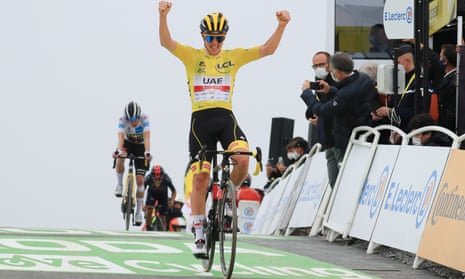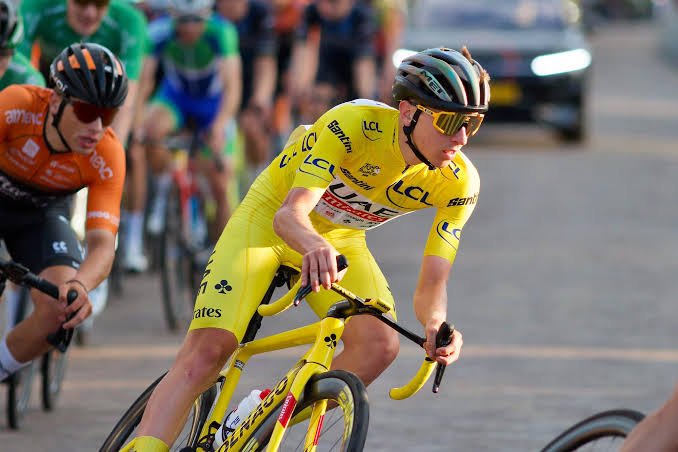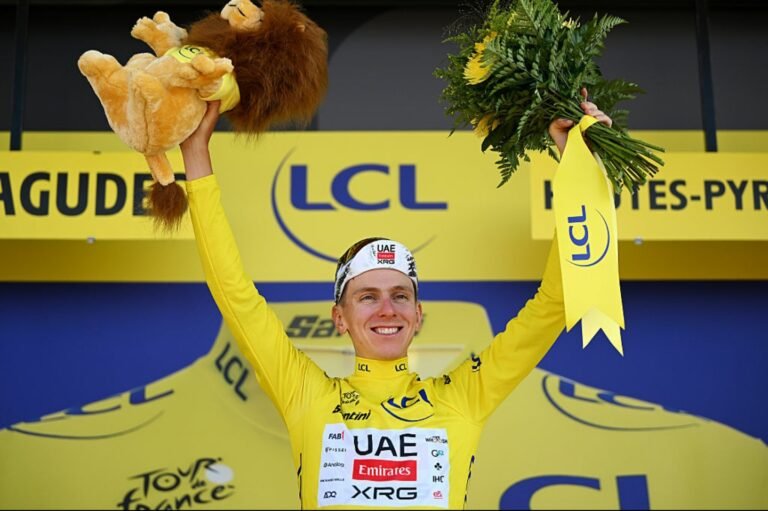
JEBEL JAIS, UNITED ARAB EMIRATES - FEBRUARY 19: Tadej Pogacar of Slovenia and UAE Team Emirates celebrates at finish line as stage winner during the 7th UAE Tour 2025, Stage 3 a 181km stage from Ras al Khaimah to Jebel Jais 1490m / #UCIWWT / on February 19, 2025 in Jebel Jais, United Arab Emirates. (Photo by Dario Belingheri/Getty Images)
Tadej Pogačar’s victory in his first race of the 2025 season is one for the books. As a rider with an already decorated career, he continues to impress with his powerful performances, and his latest triumph adds another prestigious accomplishment to his resume. But behind every victory, there’s the gear that helps make it possible—specifically the bike he rode in this race. Let’s take a closer look at the high-tech machine that helped Pogačar secure this victory, as well as some of the innovative features that set it apart from the competition.
Pogačar’s bike for this race was nothing short of extraordinary. It’s common knowledge that in professional cycling, the equipment can make a world of difference, and that’s something Pogačar and his team clearly know well. From frame design to wheels, handlebars, and tires, every element of the bike was tailored to suit the terrain and demands of the race. This focus on precision engineering allowed Pogačar to push his limits, particularly in moments when every second counted.
The bike he rode in his 2025 debut is a prime example of cutting-edge technology designed to enhance performance in every aspect. Whether it’s the aerodynamic enhancements, the lightweight materials, or the drivetrain efficiency, each component was carefully selected to support Pogačar in his bid for victory.
One standout feature of the bike was its frame construction. As we’ve seen in recent years, frame design has evolved rapidly, with manufacturers constantly pushing the envelope in terms of weight, stiffness, and aerodynamics. This particular model was engineered with the latest carbon fiber technology, resulting in a frame that’s both incredibly light and rigid enough to withstand the stresses of high-speed racing. The geometry of the frame also played a crucial role in Pogačar’s comfort and positioning on the bike, helping him maintain power output during long stretches and sharp turns alike.
In addition to the frame, the wheels and tires were an important part of the equation. Pogačar’s bike featured custom-made carbon wheels that are both lightweight and incredibly strong, designed to handle the demands of elite-level cycling while providing a smooth ride. These wheels, paired with high-performance tires, ensured maximum grip on the road, even under the toughest conditions. Whether he was tackling climbs or descending at top speeds, the wheels offered stability and responsiveness that helped Pogačar gain precious seconds over his competitors.
The bike was also outfitted with an advanced groupset, a crucial component of any top-level racing bike. The drivetrain on this bike was designed to deliver fast, precise shifts, even under high pressure. This allowed Pogačar to efficiently transition between gears during his climbs and sprints, maintaining a consistent cadence and optimizing his power output at all times. The smoothness of the shifting system played a significant role in ensuring that Pogačar could focus entirely on the race, rather than worrying about technical issues.
Another highlight was the cockpit setup. Pogačar’s bike featured an integrated handlebar and stem design that offered improved aerodynamics, while also maintaining comfort and control. This streamlined setup minimized drag, which was essential in the pursuit of every possible advantage during the race. Pogačar, known for his ability to stay focused and composed under pressure, had a setup that allowed him to remain comfortable and efficient, regardless of the terrain.
The bike’s overall design also considered the rider’s needs during the race, with an emphasis on comfort and support. Given the intense physical effort required during a race, Pogačar’s position on the bike was adjusted for optimal power transfer and aerodynamics. The saddle, too, was carefully selected for comfort during long hours of riding, ensuring that Pogačar could maintain his focus on the race without being distracted by discomfort.
But beyond the equipment itself, the bike’s role in Pogačar’s victory can’t be overstated. It wasn’t just about the technology—it was about how the machine worked in harmony with his skill and experience. The bike allowed him to push the limits of his performance, delivering when it mattered most. Every feature, from the frame to the wheels to the groupset, contributed to his overall success. And while we can point to the bike’s specifications and components, it’s clear that the synergy between rider and machine was crucial to the victory.
Pogačar’s relationship with his bike is built on years of experience and countless hours of fine-tuning. As someone who is intimately familiar with his equipment, Pogačar is able to get the best out of the technology at his disposal. This understanding of his bike, combined with his natural talent and dedication to the sport, is what makes him such a formidable competitor.
Tom’s Insight into Cycling Tech
Now, let’s take a moment to introduce Tom, a key figure in the cycling tech world. Tom became a tech writer for the Cyclingnews team in late 2022, bringing with him a wealth of experience in both cycling and mechanics. Although he holds a degree in English Literature, Tom has devoted his entire career to the cycling industry, working in various capacities. His extensive experience as a certified mechanic, along with his time spent running an independent workshop for five years, makes him uniquely qualified to analyze and evaluate high-level cycling technology.
Tom has spent more than a decade immersed in the cycling world, gaining an in-depth understanding of professional team technology and the components that make up a world-class race bike. As someone who has raced at a national level in both road and track cycling, Tom is well-versed in the nuances of racing, including the importance of having the right equipment.
His experience is not limited to just riding bikes—he’s equally comfortable in the garage, analyzing and working on bikes to understand their inner workings. This hands-on approach allows him to provide valuable insights into the technology behind the gear that elite cyclists like Pogačar use to compete at the highest level. Over his career, Tom has interviewed some of the sport’s biggest names, including Mathieu van der Poel, Tadej Pogačar, and Alberto Contador. He’s also covered numerous bike launches and events, offering expert opinions on everything from aerodynamics to comfort features.
Tom’s extensive knowledge of cycling technology allows him to see the subtle differences in professional bikes and identify cutting-edge innovations that improve performance. As he continues to follow developments in the sport, Tom remains dedicated to bringing readers the latest insights into the world of cycling technology.


